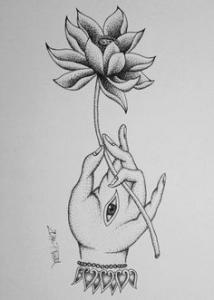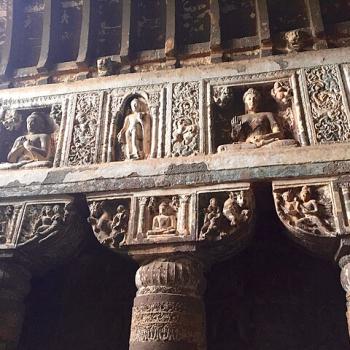I find the great gift of the Mahayana Buddhist tradition is expressed within the four seals of existence, the two truths, and the three bodies of the buddha.
While I am wary of dogmas, I find these the most helpful pointers to the structures of the human heart of any I’ve encountered in my life. While all things need to be held lightly, subject to mutation and change, these have been the pointers that have so far proven as true as anything I’ve encountered in this saha world, in this passing world.
These assertions about reality and how to find it down to my bones and marrow are why I call myself a Buddhist, and why of the many authentic ways, I bow into the specific tradition that is Zen. If there are any authentic first principles to a spiritual life, certainly the Zen Buddhist spiritual life, they are these.
The four seals are observations about the nature of things, and specifically our human condition. The formulation of the four seals don’t seem to date much earlier than the “The Questions of the Nāga King Sāgara,” the Sāgaranāgarājaparipṛcchā, which itself doesn’t seem to date earlier than the third century before our common era, and is likely much later. Of course, it is simply an explicit ordering of what had been taught for hundreds of years as the heart of the Buddha’s teaching.
The first three are:
1) Impermanence: Everything is made of parts, and they will inevitably come apart. This speaks to the fundamental structures of the universe as well as to the creation of our minds. But it is the mind, it is the heart that it’s most critical for us to understand. We are real. But we are impermanent.
2) No-self or the Emptiness of Self: There is no abiding self. The self is real. As I said, we are real, you and I. Pinch us and we hurt. But our exist4ence is mutable. And in the end, we are mortal. Nothing escapes the dissolution of the body. The wonderful mystery that we are, our unique noticing of the universe, our little corner ends.
3) Dis-ease or Disquiet: The motion of things rising and falling is experienced by humans as painful, causing anxiety and anguish. I call this encounter the buzz. The buzz is in the back of everything we encounter, behind every victory.
These first three are found in some lists as the “marks of existence.” But I find they lack something. And that something is expressed as the fourth seal.
4) There is a way through the hurt. This is the good news of Zen Buddhism. While the buzz belongs to the universe, it’s the experience of everything in motion, the buzz as discomfort, dis-ease, anxiety, or anguish belongs specifically to our human world. Given the size of the cosmos, “human” here would be any being with a consciousness that can discern the first three seals.
There is a way through. Call it enlightenment. Call it awakening. Call it peace.
Buddhism, Zen, is about awakening. The fourth seal of the intimate way.
And there two other teachings that are the great gifts of the Buddha way. Of the next can argue whether it is implicit in the earliest strata of teachings. I think so. But, more importantly, the “two truths” reached its normative form with the fourth century monk Nagarjuna. He established the exact identity of the world as understood with the image of dependent origination and boundlessness. The two truths can be summarized as:
1) Form: Everything exists within a play of mutual causality, creating, living, dying.
2) Emptiness: The absolute emptiness of these rising and falling things.
We humans naturally apprehend the first by close observation. While the second is recessive, and we normally have to seek it with the aid of practices of presence.
Rather more complex is the radical identity of these two truths. While it is possible to find these principles within the Nikayas, the earliest preserved writings, they are not developed for hundreds of years. This is where Nagarjuna and the great apophatic texts, like the Prajnaparamita cycle, sing into our hearts an ancient truth. The formless world and the world of form are in fact one thing.
The second century monk Nagarjuna is generally credited for sorting it out. He presents the facts of these two truths and their absolute identity with the sharpest of razors. Nagarjuna takes no prisoners. Personally, I’ve found what it can really mean best when this insight and the attendant practices to support finding it began in China. The encounters of Zen adepts, as they say, showed rather than explained. And then, again for me, especially through Eihei Dogen’s poetic pen, I found my heart and my being drawn into what these two truths mean as a living reality.
For us on the Zen way the spiritual project is living into these truths. We normally start with our plain observation of the phenomenal world. It is as it is. While temporary and causally related, it is real. And. The next thing to notice is how everything within the phenomenal world is wildly open, boundless, empty.
The spiritual project is to notice the world that we are, that we are boundless, and then beyond either sense of separation. And then letting go of that sense of beyond separation. What in the Zen way is called “not one, not two.”
In many ways this is the pivot observation for Zen.
And there’s one more point, a critical gift of the great way.
Trikaya, the doctrine of the three bodies of Buddha is fully developed by the beginning of the fourth century in the Yogacara school. It describes how we encounter reality. The first two are touched on a lot in Buddhist thinking and within the disciplines of Zen. And, personally, I’m finding the third increasingly important.
1) Nirmanakaya: Within history and within that rising and falling of things.
2) Dharmakaya: As totally empty of substance. There is no part that abides. Everything passes.
3) Sambhogakaya: And a third place, one of mystery. Traditionally this is the “body of bliss.” In my own path I’ve noticed it somewhat differently. Perhaps under the influence of James Hillman and Archetypal psychology, which I’ll discuss in more detail later, but more because of my own experiences tumbling into that liminal space that is not exactly dharmakaya, not exactly nirmanakaya. Increasingly this is my place. Here is where our human minds and hearts engage the mystery. Where the rising and falling feels less concrete, and more fluid. Dream and metaphor are the language of this body.
But, as wonderful as this is, it doesn’t end there. I think of that indigenous woman, so tiny, and her child. Hungry. I think of all the sufferings of our human condition. Those beyond our control, and those within our hands to change.
In this world where we notice we exist within bonds of connection.
This is not about lists. It isn’t about the finest analysis. It’s about a hungry child. It’s about my restless heart. It’s about how we meet the world. And I cannot express my gratitude enough for finding it. Actually, it feels something deeper than finding. As the Zen teacher Zenju Earthlyn Manuel says “It is all very natural to me. I welcome the Dharma as it has welcomed me long before I was born.”
It is organic. It is physical. It is intimate.
It is about not turning away. It is about leaning into the gift and learning to hold with open hands. A bad metaphor, but I hope it points. Hold all things to your heart. But be ready to let go. Mary Oliver sings it best: “To live in this world, you must be able to do three things: to love what is mortal; to hold it against your bones knowing your own life depends on it; and, when the time comes to let it go, to let it go.”
I feel the tugs of our connections. While in some ultimate sense these connections are touchable, but they are not a place we can live. It is boundless and open. Ineffable. Our profound connections with each other and the world become the background of our knowing.
Everything, every blessed thing is joined most intimately within a wild openness.













